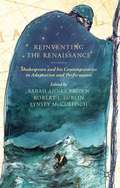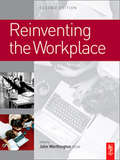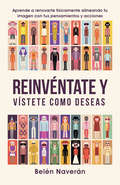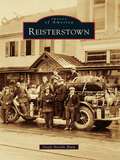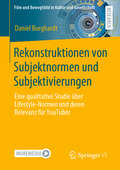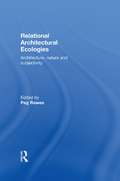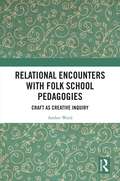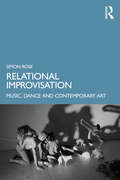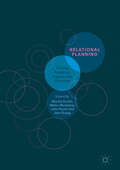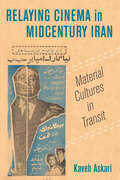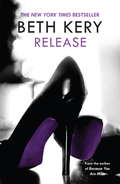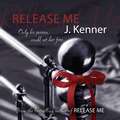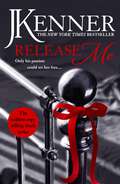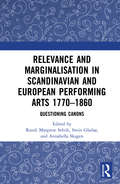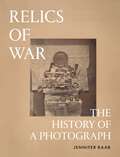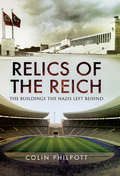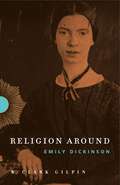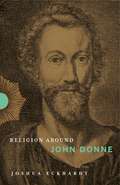- Table View
- List View
Reinventing the Renaissance
by Sarah Annes Brown Robert I. Lublin Lynsey MccullochThe plays of Shakespeare and his contemporaries has inspired interpretations in every genre and medium. This book offers perspectives on the ways in which practitioners have used Renaissance drama to address contemporary concerns and reach new audiences. It provides a resource for those interested in the creative reception of Renaissance drama.
Reinventing the Workplace
by John WorthingtonIncorporating a diversity of practices, cultural and organization change, and new building forms, this book provides ideas, inspiration and analysis of the multitude of ways in which an office space can be designed and utilized. Updated to cope with technological advances, as well as including a new series of case studies on recent Australian, North American and Scandinavian experiences, the contributors draw on a wealth and variety of professional experience to present the best and most innovative solutions for today's office - and tomorrow's workplace.
Reinvéntate y vístete como deseas: Aprende a renovarte físicamente alineando tu imagen con tus pensamientos y accio
by Belén NaveránCómo reinventarte físicamente conforme a quién eres en el momento presente. <P><P>El propósito de este libro es ayudar a reinventarse físicamente a quien esté buscando un cambio en su vida, ya sea hombre o mujer, con independencia de su edad. A lo largo de la obra se repasan los diferentes ámbitos que componen nuestra realidad personal y profesional, nuestras actividades y costumbres, etc., con la intención de reflexionar sobre ellos y eliminar todo aquello que ya no nos representa. <P><P>Se trata de renovarnos desde el interior a través de nuestros pensamientos, y guiarnos mediante ciertas pautas y sugerencias para que ese cambio se refleje en nuestro vestuario y en nuestra imagen en general. <P><P>Cada uno de los apartados de este libro es un paso que nos ayudará a convertirnos físicamente en quienes somos en el momento presente e identificarnos con nuestro nuevo yo; y nos facilitará algunas claves para poder transformarnos, siempre que necesitemos un cambio.
Reisterstown
by Gayle Neville BlumBefore it was a colonial village, Reister's Town was home to tribes of the Susquehanna who lived and hunted plentiful wildlife amidst the dense primeval woods. Travelers journeyed on narrow Native American trails from remote areas through what is now Reisterstown while on their way to the nearby bustling harbor in Baltimore Town. Dirt roads afforded a tiresome trip, and a man's throat would easily become parched from the dust. John Reister, an enterprising German immigrant, was one of these early travelers. Reister recognized that the area, only a day's travel from Baltimore, would make an ideal site for an inn where weary travelers could rest and recoup. In 1758, Reister founded the town on 20 acres that the Calverts had granted him. Soon after, in 1768, Daniel Bower, a Revolutionary War colonel, settled on nearby land and built a tavern reputed to have accommodated George Washington. By 1800, Reister's Town was a busy community boasting shops, a tannery, blacksmith, inn, and taverns, which were all vital to the growth of the town and nearby communities.
Rekonstruktionen von Subjektnormen und Subjektivierungen: Eine qualitative Studie über Lifestyle-Normen und deren Relevanz für YouTuber (Film und Bewegtbild in Kultur und Gesellschaft)
by Daniel BurghardtAnhand detaillierter Analysen von YouTube-Videos verdeutlicht das Buch, welch zentrale Rolle Subjektnormen für verschiedene Produzent_innen von Lifestyle-Videos spielen. Hierbei werden sowohl unterschiedliche Normen sichtbar, als auch deren Relationen zum Habitus der Untersuchten, welche sich in Aneignungs-, Passungs- und Spannungsverhältnissen sowie in Widersetzungen ausdrücken. Im Kontext der Subjektivierungsforschung und deren Bezugnahme auf Althusser und Foucault lassen sich jene Ausrichtungen als Subjektivierungen deuten, die mal mehr, mal weniger reflektiert vollzogen werden.
Relational Architectural Ecologies: Architecture, Nature and Subjectivity
by Peg RawesExamining the complex social and material relationships between architecture and ecology which constitute modern cultures, this collection responds to the need to extend architectural thinking about ecology beyond current design literatures. This book shows how the ‘habitats’, ‘natural milieus’, ‘places’ or ‘shelters’ that construct architectural ecologies are composed of complex and dynamic material, spatial, social, political, economic and ecological concerns. With contributions from a range of leading international experts and academics in architecture, art, anthropology, philosophy, feminist theory, law, medicine and political science, this volume offers professionals and researchers engaged in the social and cultural biodiversity of built environments, new interdisciplinary perspectives on the relational and architectural ecologies which are required for dealing with the complex issues of sustainable human habitation and environmental action. The book provides: 16 essays, including two visual essays, by leading international experts and academics from the UK, US, Australia, New Zealand and Europe; including Rosi Braidotti, Lorraine Code, Verena Andermatt Conley and Elizabeth Grosz A clear structure: divided into 5 parts addressing bio-political ecologies and architectures; uncertain, anxious and damaged ecologies; economics, land and consumption; biological and medical architectural ecologies; relational ecological practices and architectures An exploration of the relations between human and political life An examination of issues such as climate change, social and environmental well-being, land and consumption, economically damaging global approaches to design, community ecologies and future architectural practice.
Relational Encounters with Folk School Pedagogies: Craft as Creative Inquiry
by Amber WardThis book explores folk school pedagogies through craft as creative inquiry. Using a study at and inspired by The Clearing Folk School, a continuing education institution located at the northern tip of the Door County Peninsula, Wisconsin, United States, it explores the crafting of teaching practices from learners, educators, researchers, artists, animals, land, plants, and sky. The author shows how such practices function as an antidote to contemporary anthropocentric, environmental, and political crises. Contributing to conversations in posthuman ethics, it engages folk school pedagogies between humans and more-than-humans through thinking, writing, folding, interviewing, collaging, and journaling. Exploring craft as creative inquiry that works against conventional methods of and assumptions about research, it ultimately investigates the utility of folk school teaching practices that highlight relations between beings and things as kin. As such, it will appeal to scholars, researchers, faculty, and postgraduate students working across research methods, arts education, and educational philosophy by taking seriously relational pedagogies and perspectives through craft as creative inquiry.
Relational Improvisation: Music, Dance and Contemporary Art
by Simon RoseRelational Improvisation explores the creative exchanges that occur between artistic disciplines through the practice of improvisation in performance. Building upon the growing research into improvisation, the book explores contemporary transdisciplinary collaborations between improvised music and other fields including dance and visual arts, offering insights from a wide range of practitioners. Author Simon Rose takes a ground-up approach that places value on lived experience and reflects the value of collaboration. Mirroring improvisation’s relationality, chapters are co-authored by musicians, dancers and visual artists from diverse backgrounds who are engaged in active artistic collaborations with the author.The relational approach allows for the inclusion of improvisation’s scope and many levels. Showcasing a range of different voices, the chapters address topics in artistic improvisation including cybernetics, interspecies work, working with light, phenomenology, sympoiesis and identity, and utilise a range of approaches including autoethnography and philosophical analysis. Considering the relationships of improvisation to emotion, space, embodiment and philosophy, this book shows how improvisation, collaboration and transdisciplinary artistic practices combine to generate new creative possibilities. It provides vital insights for practicing artists, arts researchers, philosophy and pedagogy and all those studying improvisation and collaborative creativity in contemporary music, dance and visual arts.
Relational Planning
by Monika Kurath Marko Marskamp Julio Paulos Jean RueggThis volume introduces the notion of 'relational planning' through a collection of theoretical and empirical contributions that explore the making of heterogeneous associations in the planning practice. The analytical concept builds on recent approaches to complexity and materiality in planning theory by drawing on Science and Technology Studies (STS) of urban issues. It frames planning as a socio-material practice taking place within the multifaceted relations between artefacts, agency and practices. By way of this triad, spatial planning is not studied as a given, linear or technical process but rather problematized as a hybrid, distributed and situational practice. The inquiries in this collection thus describe how planning practices are negotiated and enacted in and beyond formal arenas and procedures of planning, and so make visible the many sites, actors and means of spatial planning. Addressing planning topics such as ecology, preservation, participation, rebuilding and zoning, this volume takes into account the uncertain world planning is embedded in. The implications of such a perspective are considered in light of how planning is performed and how it contributes to the emergence of specific socio-material forms and interactions. This is an invaluable read for all scholars of STS, Ecology, Architecture and Urban Planning.
Relaunching Titanic: Memory and marketing in the New Belfast
by Michael Murray William J. V. Neill Berna GristRelaunching Titanic critically considers the invocation of Titanic heritage in Belfast in contributing to a new ‘post-conflict’ understanding of the city. The authors address how the memory of Titanic is being and should be represented in the place of its origin, from where it was launched into the collective consciousness and unconscious of western civilization. Relaunching Titanic examines the issues in the context of international debates on the tension between place marketing of cities and other alternative portrayals of memory and meaning in places. Key questions include the extent to which the goals of economic development are congruous with the ‘contemplative city’ and especially the need for mature and creative reflection in the ‘post-conflict’ city, whether development interests have taken precedence over the need for a deeper appreciation of a more nuanced Titanic legacy in the city of Belfast, and what Belfast shares with other places in considering the sacred and profane in memory construction. While Relaunching Titanic focuses on the conflicted history of Belfast and the Titanic, it will have lessons for planners and scholars of city branding, tourism, and urban re-imaging.
Relaying Cinema in Midcentury Iran: Material Cultures in Transit (Cinema Cultures in Contact #2)
by Kaveh AskariRelaying Cinema in Midcentury Iran investigates how the cultural translation of cinema has been shaped by the physical translation of its ephemera. Kaveh Askari examines film circulation and its effect on Iranian film culture in the period before foreign studios established official distribution channels and Iran became a notable site of world cinema. This transcultural history draws on cross-archival comparison of films, distributor memos, licensing contracts, advertising schemes, and audio recordings. Askari meticulously tracks the fragile and sometimes forgotten material of film as it circulated through the Middle East into Iran and shows how this material was rerouted, reengineered, and reimagined in the process.
Release
by Beth KeryFor fans for Sylvia Day, J. Kenner and Maya Banks. A sexy, thrilling erotic romance from the New York Times ebook bestselling author of the Because You Are Mine series and The Affair.Genny loved her husband Max, but something was missing - a sexual charge that was instead ignited by his business partner, Sean. He was ruggedly handsome, with a heart-stopping smile and a slow, sexy New Orleans drawl that made Genny weak. The more time they spent together, the stronger the attraction between them became and when her husband offered to share her with Sean for one intoxicating night, both Genny and Sean were too tempted to refuse. That night in the company penthouse, Max and Sean showed Genny the heights of ecstasy. But it was Sean who scored her very spirit, and one-on-one, they were red hot. But as Genny learns, there's a price to pay for such impulsive pleasure. What began as a night of forbidden desire spirals into a whirlpool of murder, sensual submission, secrets, and a scorching passion that threatens to consume everyone it touches.Enter the seductive world of Beth Kery where the rules are broken with that first electrifying touch in the sizzling Because You Are Mine, One Night of Passion and The Affair novels.
Release Me: Stark Series Book 1 (Stark Series #3)
by J. KennerThe first in an irresistible, erotic, emotionally charged romance series for fans of Fifty Shades of Grey and Bared To You of a powerful man who's never heard 'no', a fiery woman who says 'yes' on her own terms and an unforgettable indecent proposal...He was the one man I couldn't avoid. And the one man I couldn't resist. Damien Stark could have his way with any woman. He was sexy, confident, and commanding: anything he wanted, he got. And what he wanted was me.Our attraction was unmistakable, almost beyond control, but as much as I ached to be his, I feared the pressures of his demands. Submitting to Damien meant I had to bare the darkest truth about my past - and risk breaking us apart.But Damien was haunted, too. And as our passion came to obsess us both, his secrets threatened to destroy him - and us - for ever.Spellbinding romance. Electrifying passion. Why not indulge in J. Kenner...Discover the whole story of Damien and Nikki's epic romance in J. Kenner's hot and addictive bestselling Stark series: Release Me, Claim Me, Complete Me, Take Me, Have Me, Play My Game, Seduce Me, Unwrap Me, Deepest Kiss, Entice Me and Anchor Me.(P)2013 Headline Digital
Release Me: The first irresistibly sexy novel in the iconic Stark series (Stark Series #1)
by J. Kenner'In a class of its own . . . An outstanding book and a definite page turner for any Fifty Shades fan!' ⭐ ⭐ ⭐ ⭐ ⭐Irresistible. Erotic. Emotionally charged. The unforgettable multi-million copy selling series, which started with an unforgettable indecent proposal . . .'Damien Stark is definitely up there on my list of sex gods!!' ⭐ ⭐ ⭐ ⭐ ⭐'If you are addicted to hot alpha males then this is a trilogy to add to your list' ⭐ ⭐ ⭐ ⭐ ⭐'Oh wow!! I think I've discovered another black knight in shining armour, Damien is awesome, loving and so so HOT' ⭐ ⭐ ⭐ ⭐ ⭐'Move over Christian Gray there is a new HOT HOT guy on the block' ⭐ ⭐ ⭐ ⭐ ⭐'This is even better then FSOG' ⭐ ⭐ ⭐ ⭐ ⭐'I am a massive fan of Sylvia Day and E. L. James and didn't think that anything else could top those authors . . . I was definitely wrong!! . . . I couldn't put it down . . . BRILLIANT' ⭐ ⭐ ⭐ ⭐ ⭐..............................................He was the one man I couldn't avoid. And the one man I couldn't resist.Damien Stark could have his way with any woman. He was sexy, confident, and commanding: anything he wanted, he got. And what he wanted was me.Our attraction was unmistakable, almost beyond control, but as much as I ached to be his, I feared the pressures of his demands. Submitting to Damien meant I had to bare the darkest truth about my past - and risk breaking us apart.But Damien was haunted, too. And as our passion came to obsess us both, his secrets threatened to destroy him - and us - for ever...............................................Spellbinding romance. Electrifying passion. Why not indulge in J. Kenner . . . The Stark Saga (full-length novels)Release MeClaim MeComplete MeAnchor MeLost With MeDamienEnchant MeStark Ever After (novellas)Take MeHave MePlay My GameSeduce MeUnwrap MeDeepest KissEntice MeHold MePlease MeIndulge MeDelight MeCherish MeEmbrace MeVisit J. Kenner's website for full reading order with spin-off stories!
Relevance and Marginalisation in Scandinavian and European Performing Arts 1770–1860: Questioning Canons
by Randi Margrete SelvikRelevance and Marginalisation in Scandinavian and European Performing Arts 1770–1860: Questioning Canons reveals how various cultural processes have influenced what has been included, and what has been marginalised from canons of European music, dance, and theatre around the turn of the nineteenth century and the following decades. This collection of essays includes discussion of the piano repertory for young ladies in England; canonisation of the French minuet; marginalisation of the popular German dramatist Kotzebue from the dramatic canon; dance repertory and social life in Christiania (Oslo); informal cultural activities in Trondheim; repertory of Norwegian musical clocks; female itinerant performers in the Nordic sphere; preconditions, dissemination, and popularity of equestrian drama; marginalisation and amateur staging of a Singspiel by the renowned Danish playwright Oehlenschläger, also with perspectives on the music and its composers; and the perceived relevance of Henrik Ibsen’s staged theatre repertory and early dramas. By questioning established notions about canon, marginalisation, and relevance within the performing arts in the period 1770–1860, this book asserts itself as an intriguing text both to the culturally interested public and to scholars and students of musicology, dance research, and theatre studies.
Relics and Writing in Late Medieval England
by Robyn MaloRelics and Writing in Late Medieval England uncovers a wide-ranging medieval discourse that had an expansive influence on English literary traditions. Drawing from Latin and vernacular hagiography, miracle stories, relic lists, and architectural history, this study demonstrates that, as the shrines of England's major saints underwent dramatic changes from c. 1100 to c. 1538, relic discourse became important not only in constructing the meaning of objects that were often hidden, but also for canonical authors like Chaucer and Malory in exploring the function of metaphor and of dissembling language.Robyn Malo argues that relic discourse was employed in order to critique mainstream religious practice, explore the consequences of rhetorical dissimulation, and consider the effect on the socially disadvantaged of lavish expenditure on shrines. The work thus uses the literary study of relics to address issues of clerical and lay cultures, orthodoxy and heterodoxy, and writing and reform.
Relics of War: The History of a Photograph
by Jennifer RaabHow a single haunting image tells a story about violence, mourning, and memoryIn 1865, Clara Barton traveled to the site of the notorious Confederate prison camp in Andersonville, Georgia, where she endeavored to name the missing and the dead. The future founder of the American Red Cross also collected their relics—whittled spoons, woven reed plates, a piece from the prison&’s &“dead line,&” a tattered Bible—and brought them back to her Missing Soldiers Office in Washington, DC, presenting them to politicians, journalists, and veterans&’ families before having them photographed together in an altar-like arrangement. Relics of War reveals how this powerful image, produced by Mathew Brady, opens a window into the volatile relationship between suffering, martyrdom, and justice in the wake of the Civil War.Jennifer Raab shows how this photograph was a crucial part of Barton&’s efforts to address the staggering losses of a war in which nearly half of the dead were unnamed and from which bodies were rarely returned home for burial. The Andersonville relics gave form to these absent bodies, offered a sacred site for grief and devotion, mounted an appeal on behalf of the women and children left behind, and testified to the crimes of war. The story of the photograph illuminates how military sacrifice was racialized as political reconciliation began, and how the stories of Black soldiers and communities were silenced.Richly illustrated, Relics of War vividly demonstrates how one photograph can capture a precarious moment in history, serving as witness, advocate, evidence, and memory.
Relics of the Reich: The Buildings the Nazis Left Behind
by Colin PhilpottThe author of Secret Wartime Britain examines the architecture left behind after the Nazis were defeated in World War II. Hitler&’s Reich may have been defeated in 1945, but many buildings, military installations, and other sites remained. At the end of the war, some were obliterated by the victorious Allies, but others survived. For almost fifty years, these were left crumbling and ignored with post-war and divided Germany unsure what to do with them, often fearful that they might become shrines for neo-Nazis. Since the early 1990s, Germans have come to terms with these iconic sites and their uncomfortable part. Some sites are even listed buildings.Relics of the Reich visits many of the buildings and structures built or adapted by the Nazis and looks at what has happened since 1945 to uncover what it tells us about Germany&’s attitude to Nazism now. It also acts as a commemoration of mankind&’s deliverance from a dark decade and serves as renewal of our commitment to ensure history does not repeat itself.
Religion Around Emily Dickinson (Religion Around #2)
by W. Clark GilpinReligion Around Emily Dickinson begins with a seeming paradox posed by Dickinson’s posthumously published works: while her poems and letters contain many explicitly religious themes and concepts, throughout her life she resisted joining her local church and rarely attended services. Prompted by this paradox, W. Clark Gilpin proposes, first, that understanding the religious aspect of the surrounding culture enhances our appreciation of Emily Dickinson’s poetry and, second, that her poetry casts light on features of religion in nineteenth-century America that might otherwise escape our attention. Religion, especially Protestant Christianity, was “around” Emily Dickinson not only in explicitly religious practices, literature, architecture, and ideas but also as an embedded influence on normative patterns of social organization in the era, including gender roles, education, and ideals of personal intimacy and fulfillment. Through her poetry, Dickinson imaginatively reshaped this richly textured religious inheritance to create her own personal perspective on what it might mean to be religious in the nineteenth century. The artistry of her poetry and the profundity of her thought have meant that this personal perspective proved to be far more than “merely” personal. Instead, Dickinson’s creative engagement with the religion around her has stimulated and challenged successive generations of readers in the United States and around the world.
Religion Around Emily Dickinson (Religion Around)
by W. Clark GilpinReligion Around Emily Dickinson begins with a seeming paradox posed by Dickinson’s posthumously published works: while her poems and letters contain many explicitly religious themes and concepts, throughout her life she resisted joining her local church and rarely attended services. Prompted by this paradox, W. Clark Gilpin proposes, first, that understanding the religious aspect of the surrounding culture enhances our appreciation of Emily Dickinson’s poetry and, second, that her poetry casts light on features of religion in nineteenth-century America that might otherwise escape our attention. Religion, especially Protestant Christianity, was “around” Emily Dickinson not only in explicitly religious practices, literature, architecture, and ideas but also as an embedded influence on normative patterns of social organization in the era, including gender roles, education, and ideals of personal intimacy and fulfillment. Through her poetry, Dickinson imaginatively reshaped this richly textured religious inheritance to create her own personal perspective on what it might mean to be religious in the nineteenth century. The artistry of her poetry and the profundity of her thought have meant that this personal perspective proved to be far more than “merely” personal. Instead, Dickinson’s creative engagement with the religion around her has stimulated and challenged successive generations of readers in the United States and around the world.
Religion Around John Donne (Religion Around #4)
by Joshua EckhardtIn this volume, Joshua Eckhardt examines the religious texts and books that surrounded the poems, sermons, and inscriptions of the early modern poet and preacher John Donne. Focusing on the material realities legible in manuscripts and Sammelbände, bookshops and private libraries, Eckhardt uncovers the myriad ways in which Donne’s writings were received and presented, first by his contemporaries, and later by subsequent readers of his work.Eckhardt sheds light on the religious writings with which Donne’s work was linked during its circulation, using a bibliographic approach that also informs our understanding of his work’s reception during the early modern period. He analyzes the religious implications of the placement of Donne’s poem “A Litany” in a library full of Roman Catholic and English prayer books, the relationship and physical proximity of Donne’s writings to figures such as Sir Thomas Egerton and Izaak Walton, and the movements in later centuries of Donne’s work from private owners to the major libraries that have made this study possible. Eckhardt’s detailed research reveals how Donne’s writings have circulated throughout history—and how religious readers, communities, and movements affected the distribution and reception of his body of work.Centered on a place in time when distinct methods of reproduction, preservation, and circulation were used to negotiate a complex and sometimes dangerous world of confessional division, Religion Around John Donne makes an original contribution to Donne studies, religious history, book history, and reception studies.
Religion Around Virginia Woolf (Religion Around #6)
by Stephanie PaulsellVirginia Woolf was not a religious person in any traditional sense, yet she lived and worked in an environment rich with religious thought, imagination, and debate. From her agnostic parents to her evangelical grandparents, an aunt who was a Quaker theologian, and her friendship with T. S. Eliot, Woolf’s personal circle was filled with atheists, agnostics, religious scholars, and Christian converts. In this book, Stephanie Paulsell considers how the religious milieu that Woolf inhabited shaped her writing in unexpected and innovative ways.Beginning with the religious forms and ideas that Woolf encountered in her family, friendships, travels, and reading, Paulsell explores the religious contexts of Woolf’s life. She shows that Woolf engaged with religion in many ways, by studying, reading, talking and debating, following controversies, and thinking about the relationship between religion and her own work. Paulsell examines the ideas about God that hover around Woolf’s writings and in the minds of her characters. She also considers how Woolf, drawing from religious language and themes in her novels and in her reflections on the practices of reading and writing, created a literature that did, and continues to do, a particular kind of religious work.A thought-provoking contribution to the literature on Woolf and religion, this book highlights Woolf’s relevance to our post-secular age. In addition to fans of Woolf, scholars and general readers interested in religious and literary studies will especially enjoy Paulsell’s well-researched narrative.
Religion Around Virginia Woolf (Religion Around)
by Stephanie PaulsellVirginia Woolf was not a religious person in any traditional sense, yet she lived and worked in an environment rich with religious thought, imagination, and debate. From her agnostic parents to her evangelical grandparents, an aunt who was a Quaker theologian, and her friendship with T. S. Eliot, Woolf’s personal circle was filled with atheists, agnostics, religious scholars, and Christian converts. In this book, Stephanie Paulsell considers how the religious milieu that Woolf inhabited shaped her writing in unexpected and innovative ways.Beginning with the religious forms and ideas that Woolf encountered in her family, friendships, travels, and reading, Paulsell explores the religious contexts of Woolf’s life. She shows that Woolf engaged with religion in many ways, by studying, reading, talking and debating, following controversies, and thinking about the relationship between religion and her own work. Paulsell examines the ideas about God that hover around Woolf’s writings and in the minds of her characters. She also considers how Woolf, drawing from religious language and themes in her novels and in her reflections on the practices of reading and writing, created a literature that did, and continues to do, a particular kind of religious work.A thought-provoking contribution to the literature on Woolf and religion, this book highlights Woolf’s relevance to our post-secular age. In addition to fans of Woolf, scholars and general readers interested in religious and literary studies will especially enjoy Paulsell’s well-researched narrative.
Religion and Aesthetic Experience in Joyce and Yeats
by Tudor BalinisteanuThis monograph is based on archival research and close readings of James Joyce's and W. B. Yeats's poetics and political aesthetics. Georges Sorel's theory of social myth is used as a starting point for exploring the ways in which the experience of art, like that of social myth, can be seen as a form of religious experience. The theorisation of the experience of art as a form of religious experience illuminates the role of art in engendering social attitudes in opposition to economic materialism and capitalism. Based on these analyses, the arguments explore the ways in which a theory that defines the experience of art as a form of religious experience can help us to answer three questions of pressing interest for the contemporary moment: How can we read cultural texts to imagine forms of social belonging through which to challenge the isolation of economic materialism? How can we imagine cultural texts to create the collective relations necessary for social change in global capitalism? How can we define an ethics of satisfaction that does not relate to this capital modernity?
Religion and Contemporary Art: A Curious Accord
by Ronald R. BernierReligion and Contemporary Art sets the theoretical frameworks and interpretive strategies for exploring the re-emergence of religion in the making, exhibiting, and discussion of contemporary art. Featuring essays from both established and emerging scholars, critics, and artists, the book reflects on what might be termed an "accord" between contemporary art and religion. It explores the common strategies contemporary artists employ in the interface between religion and contemporary art practice. It also includes case studies to provide more in-depth treatments of specific artists grappling with themes such as ritual, abstraction, mythology, the body, popular culture, science, liturgy, and social justice, among other themes. It is a must-read resource for working artists, critics, and scholars in this field, and an invitation to new voices "curious" about its promises and possibilities.
